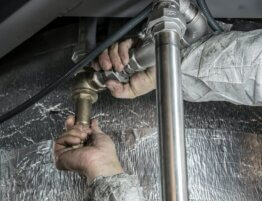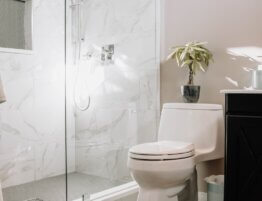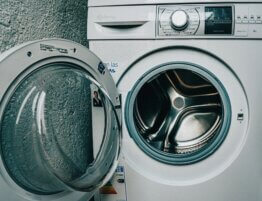
Clogged drains are a nuisance, often disrupting the smooth functioning of any household.
Enter the unassuming hero, baking soda, paired often with vinegar, forming an effervescent duo that easily tackles the stubborn blockages.
This combination is simple yet effective and activates a chemical reaction that can clear the path for water to flow freely once again.
By mastering a few straightforward techniques, homeowners can address their clogged pipes without needing to reach for harsh chemicals or call in a professional.
Keep reading to unlock the potential of an everyday pantry staple for maintaining clear and functional drains.
Unblocking Your Drain With Baking Soda Basics
Baking soda, a versatile agent known for its cleaning prowess, emerges as a protagonist in tackling clogged pipes.
Before embarking on this cleansing journey, one must arm oneself with the appropriate tools and materials, to ensure a seamless experience.
The efficacy of the baking soda fix is contingent on specific clog scenarios, making it critical for homeowners to assess the suitability of this method for their particular plumbing issue.
As you prepare to restore the free flow of your drains, let us equip you with insights to determine the right moment for this eco-friendly intervention.
Gather the Necessary Tools and Materials
Embarking on a baking soda drain cleanse requires knowledge and the right assortment of tools. A flexible, sturdy plunger remains an indispensable ally, capable of dislodging minor blockages before the introduction of baking soda. Ensuring that a jug of white vinegar and a kettle for boiling water are within reach is equally pivotal, as these will act in concert with baking soda to dissolve stubborn clogs and refresh your pipes.
Understand When to Use the Baking Soda Fix
Identifying the appropriate circumstances for employing a baking soda solution necessitates a clear understanding of the plumbing problem at hand. Minor clogs, usually caused by organic material or grease buildup, are prime candidates for this home remedy, while more severe obstructions may call for professional intervention. Recognizing the distinction ensures the baking soda drain treatment is both effective and used judiciously:
- Assess the severity of the clog – baking soda is best for minor, non-emergency blockages.
- Note the type of waste causing the clog – organic substances like hair or food remnants respond well to baking soda.
- Evaluate previous cleaning efforts – avoid mixing baking soda with chemical drain cleaners to prevent hazardous reactions.
Step-by-Step Guide to a Baking Soda Drain Cleanse
Embarking on the mission to clear obstructed pipes can be daunting; nevertheless, with a strategic approach and a handful of household ingredients, relief from a clogged drain is within reach.
The process begins by priming the pipes with boiling water, a simple yet crucial step that softens the offending blockage.
Next, baking soda is enlisted, entering the fray as a potent clog-fighting agent.
Vinegar soon follows, its introduction sparking a chemical reaction that lifts and breaks down the stubborn residue clinging to the inner walls of the plumbing.
The operation culminates with a final hot water flush, ensuring any lingering debris is swept away.
This harmonious sequence of actions paves the way for water to resume its natural flow, reinstating tranquility to your household plumbing system.
Start With Boiling Water to Loosen the Clog
Initiating the plumbing purgation with a kettle of boiling water serves as an effective precursor, gently easing the buildup within the drain. This preliminary assault on the clog softens the accumulated debris, priming the pipes for the decongesting prowess of the baking soda mixture that follows.
Send Baking Soda on a Clog-Fighting Mission
Once the drain has been prepped with boiling water to loosen the clog’s grip, it’s time for baking soda to take center stage: a formidable foe against the gunk responsible for the blockage. Measuring half a cup of this powdery white knight and gently pouring it down the afflicted drain directly places the solution where it’s most needed, setting the stage for the upcoming chemical reaction that will help to disintegrate the obstruction.
| Step | Action | Purpose |
|---|---|---|
| 1 | Boil water | Loosen clog |
| 2 | Pour baking soda | Direct clog-fighting agent to obstruction |
| 3 | Add vinegar | Create reaction to break down clog |
| 4 | Flush with hot water | Clear out debris and refresh pipes |
Add Vinegar to Activate the Cleaning Fizz
With the stage set by boiling water and baking soda, introducing vinegar ignites a dynamic reaction, proving essential in the drain cleansing saga. A measured cup of this acidic liquid cascades down the drain, eagerly reacting with the baking soda to produce a vigorous fizz. This effervescence is more than spectacle; it dislodges grime, facilitates breakdown, and heralds the disintegration of the blockage.
- Boil a kettle of water to soften the clog.
- Deposit half a cup of baking soda into the drain, targeting the obstruction directly.
- Pour vinegar to trigger the effervescent action essential for dislodging debris.
- Conclude with a hot water flush to eliminate residual matter and ensure a pristine pipe interior.
Finish With Another Round of Hot Water
The ritual of declogging reaches its zenith with a concluding pour of hot water, which chases down the effervescent remnants from the vinegar and baking soda skirmish. This crucial action ensures any unsettled particles are thoroughly dislodged and dispatched, leaving the inner sanctum of the pipes in a refreshed and fluid state. It reaffirms the drain’s unobstructed status, signaling the end of a successful home plumbing intervention.
Enhance the Baking Soda Mixture With Common Additives
Turning the tide on challenging pipe blockages necessitates a touch of creativity beyond the basic baking soda method.
While the effervescent qualities of baking soda and vinegar often suffice, certain clog conditions call for targeting more persistent problems.
Within the domestic arsenal resides a pantheon of ingredients ready to bolster the remedial power of baking soda.
A thoughtful addition of salt can amplify the abrasive effect, whereas a dash of dish soap offers a solution adept at slicing through greasy adversaries.
Here lies the exploration of tailored augmentations designed to enhance the homemaking alchemist’s repertoire for maintaining free-flowing drains.
Amplify the Effect With Salt
Enhancing the baking soda’s abrasive power, a generous sprinkle of table salt can be introduced to the mixture, offering a coarser element that works in unison with the natural scouring characteristics of sodium bicarbonate. The presence of salt in the concoction intensifies the mechanical action needed to break down the clog and fosters a more rigorous clean, ensuring the tenacity of the blockage meets its match.
Cut Grease With Dish Soap Additions
Incorporating dish soap into the baking soda regimen offers a potent solution for cutting through grease-related clogs. The dish soap’s degreasing properties work synergistically with the natural deodorizing and cleaning effects of baking soda and vinegar, providing a robust method for disbanding oily accumulations in the drain:
- Begin with the standard baking soda and hot water procedure to soften the clog.
- Add a few squirts of dish soap to penetrate and dissolve grease build-up.
- Complement with vinegar, allowing the generated foam to work through the grease-laden obstruction.
- Finalize with a hot water flush to clear out any remaining greasy residue.
Regular Drain Maintenance Using Baking Soda
Preemptive attention to drain health circumvents the urgency of blockage removal—a regimen integrating baking soda affords homeowners the assurance of clear pipes.
Proactive application of this humble yet potent compound can mitigate the acceleration of obstructive buildup, translating to a plumbing system that maintains its integrity over time.
Regular maintenance not only prolongs the life of the drains but also fosters an environment less conducive to clog formation.
Exploring the optimal frequency of maintenance with baking soda and establishing a simple, consistent drain care routine empowers individuals to preempt plumbing predicaments effectively.
How Often Should You Use Baking Soda for Maintenance?
Establishing a routine for drain maintenance with baking soda can be remarkably conducive to long-term plumbing health. Experts recommend a monthly treatment to prevent the gradual accumulation of debris that leads to clogs: pour a half-cup of baking soda followed by a mixture of hot water and vinegar down your drains to keep them clear and odor-free.
| Frequency | Materials | Procedure |
|---|---|---|
| Monthly | Baking soda, Hot water, Vinegar | Pour baking soda into the drain, followed by hot water and vinegar, to maintain clarity and prevent odors. |
Prevent Future Clogs With a Baking Soda Routine
Embracing a baking soda routine is a prudent strategy for homeowners invested in the longevity and efficiency of their plumbing systems. By integrating a regular cadence of baking soda treatments, individuals can effectively deter the common culprits of clogs, ensuring their pipes remain pristine. This preemptive approach diminishes the likelihood of disruptive and often costly plumbing emergencies, safeguarding the smooth operation of a home’s wastewater disposal mechanisms.
The DOS and DON’TS of Baking Soda Drain Solutions
Navigating the landscape of DIY drain clearing, baking soda stands out as a favored approach.
It’s crucial to understand that not all clogs are created equal and therefore, the response to them must be tailored.
Embracing the nuances of when baking soda proves effective and when professional hands should take over is essential for both the health of your plumbing and your peace of mind.
This guide will explore the types of blockages that readily succumb to a baking soda solution and delineate circumstances under which expert intervention becomes the wiser course of action.
The Types of Clogs Baking Soda Can Dissolve
The efficacy of baking soda in combating clogs is most pronounced when dealing with blockages composed of organic substances: food remnants, hair, and soap scum, which respond to its cleansing effect. When baking soda encounters these common drain offenders, it acts as a mild abrasive and deodorizer, breaking down the debris enough to restore flow through the pipes.
- Organic material like food waste is effectively fragmented by baking soda.
- Hair clogs, often found in bathroom sinks and bathtubs, are loosened by its abrasive action.
- Soap scum, which frequently accumulates on pipe walls, is reduced, clearing narrow passageways.
When to Avoid Baking Soda and Call a Professional
Some blockage scenarios underline the necessity for professional plumbing expertise; for instance, when baking soda fails to alleviate the issue, suggesting a more complex obstruction than initially assumed. If pipes have become compromised by tree roots or severe compaction, attempting to address such extensive problems with home remedies might exacerbate the situation. In these cases, seasoned plumbers come equipped with specialized tools and know-how, ensuring safe and effective resolution without further damage to the plumbing infrastructure.
Troubleshooting Ineffective Baking Soda Treatments
Navigating the snags of DIY plumbing, one discovers that even the most trusted household remedies, like baking soda, have their limits when addressing intricate drain blockages.
When the bubbling mixture falls short, other strategies must be embraced to avoid exacerbating the problem.
This crucial juncture calls for a deeper inspection, understanding when to deploy alternative methods, or recognizing the signs that signal the need for a seasoned professional’s touch.
This section illuminates the path forward when the usual baking soda solution does not yield the anticipated results.
Identifying Complex Blockages Beyond Baking Soda’s Reach
Occasionally, a homeowner may face drainage problems that stubbornly resist the baking soda approach, suggesting a deep-set or complex clog is at play. When water refuses to drain despite repeated baking soda mixes, the obstruction is probably more formidable, possibly involving hardened sediments or non-dissolvable objects that require mechanical removal. At this crossroads, before further attempts are made, recognizing the limitations of home remedies is vital, and consulting a plumbing expert becomes a prudent step to avoid potential pipe damage.
Using baking soda, often enhanced with vinegar, hot water, and in some cases, salt or dish soap can address common blockages caused by organic materials such as food waste, hair, and soap scum.
While this method is suitable for less severe clogs and regular maintenance to prevent blockages, it’s important to recognize its limitations.
Professional assistance is advisable to prevent damage to plumbing infrastructure for complex obstructions or persistent issues.
Embracing baking soda treatments as part of a regular maintenance routine can keep pipes flowing smoothly and save homeowners from the inconvenience and expense of significant plumbing problems.
Take charge of your plumbing and bid farewell to clogged drains by unleashing the power of baking soda. Follow our simple yet effective DIY guide to clear minor blockages without harsh chemicals or professional help. Don’t wait for a plumbing emergency – use this eco-friendly solution today, or contact us for serious clogs!










